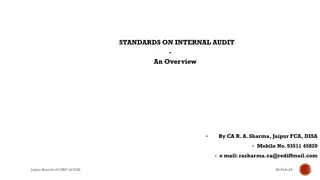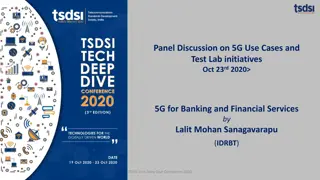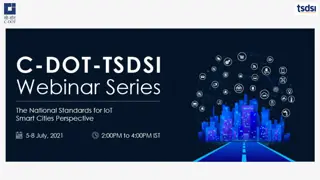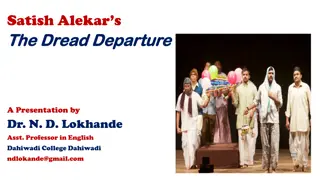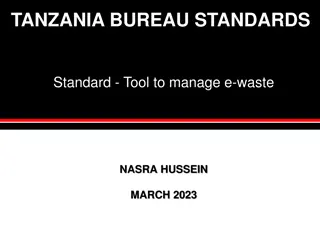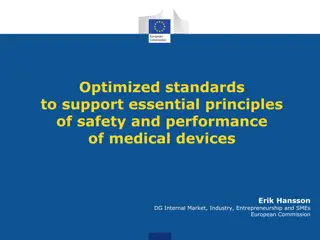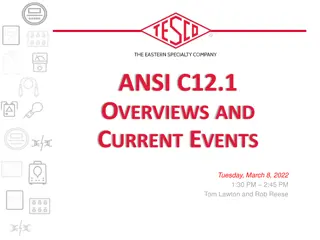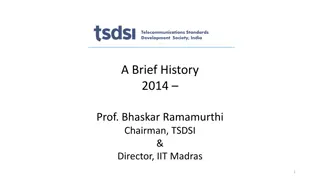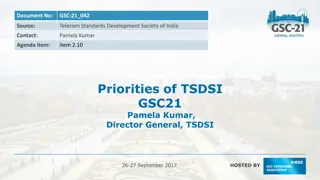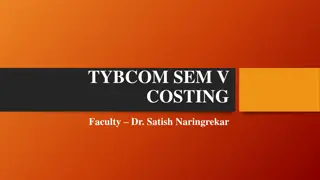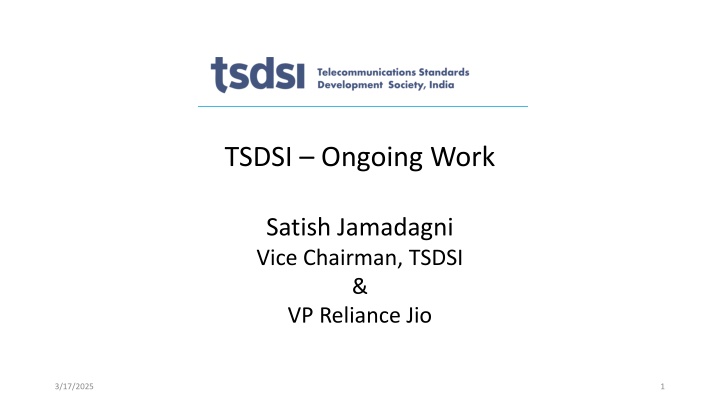
Enhancements and Proposals in TSDSI for 3GPP Release 17
TSDSI is focusing on capacity and coverage enhancements for 3GPP Release 17, including In-Band Full Duplex Study Proposal, IAB enhancements, MBMS support for 5G NR services, and more to meet the evolving needs of the Indian telecom landscape, particularly in terms of limited spectrum, massive MIMO upgrades, rural coverage, and backhaul limitations.
Download Presentation

Please find below an Image/Link to download the presentation.
The content on the website is provided AS IS for your information and personal use only. It may not be sold, licensed, or shared on other websites without obtaining consent from the author. If you encounter any issues during the download, it is possible that the publisher has removed the file from their server.
You are allowed to download the files provided on this website for personal or commercial use, subject to the condition that they are used lawfully. All files are the property of their respective owners.
The content on the website is provided AS IS for your information and personal use only. It may not be sold, licensed, or shared on other websites without obtaining consent from the author.
E N D
Presentation Transcript
TSDSI Ongoing Work Satish Jamadagni Vice Chairman, TSDSI & VP Reliance Jio 3/17/2025 1
Summary of items of interest from TSDSI for 3GPP Release 17 Capacity and Coverage enhancements (compared to Release-16) In-Band Full-Duplex Study Proposal : IAB enhancement MBMS support for 5G NR Services in 5G NR Support for SA Deployment Option-6 5G Services: IOT Platforms, Cloud Interoperability issues 2
Coverage & Capacity Enhancement Requirements Limited Spectrum LTE 20MHz (+/- 10Mhz) /per operator TDD band 40 Indian operators: Per bit pricing least in the world Most LTE cell sites near full capacity operators are exploring Massive MIMO upgrades Indian Scenario: Capacity enhancements at critical for low cost bit delivery Coverage 3.5 GHz needs to offer coverage levels comparable to LTE LMLC Rural scenario Large rural population, sparse villages, Typical Inter-site distance: 6Km - 12Km Relook at physical layer design to support at least 12-dB coverage gain Backhaul continues to be a limitation in both urban and rural use cases Need for IAB/Relays, 60Ghz solutions NB-IOT is key for Agri Tech, Smart Cities etc in India - NB-IoT enhancements for capacity / Coverage are critical 3
Massive MIMO Capacity Enhancements Capacity and Coverage 4
Pi/2 BPSK Modifications Summary Interoperable with the Indian UE and outside UEs. Utilize non-critical extensions Non-critical extensions do not break compatibility Used in 3GPP as well to maintain backward compatibility, for eg., Rel 14 and Rel 15 5
~6 db additional coverage gain compared to OFDM Backhaul Capacity and Coverage 6
In-Band Full Duplex (IBFD) gNB (Study Proposal) Fig. 1 In-band full duplex (IBFD) enabled gNB Fig. 2 Network with IBFD enabled gNBs Benefits Increase in spectral efficiency Better resource utilization Challenges Self-Interference cancellation (SIC) required at gNB Manage inter/intra UE-to-UE and gNB-to-gNB cross link interference (CLI) 7
IAB enhancement using IBFD Fig. 4: IBFD capable IAB node Backhaul link is mostly LOS link Therefore the rank will be limited to 2 This limits MIMO capability in backhaul In such case spectral efficiency of backhaul can be improved by simultaneous Tx/Rx IAB with 2x2 MIMO is a potential scenario for IBFD application Self interference cancellation is less complex 8
MBMS (Services) for 5G NR The overall scope of the work item is to identify techniques targeting MBMS deployment in NR with the following detailed objectives: Support MBMS offload mechanisms Support for MBMS in a 5G NR Private Deployment [RAN3, RAN2] 9
Support for deployment Option 6 The signaling load on the eNB when implementing 5G NR in NSA mode can be quite prohibitive specifically for operators that are facing heavy loads against their cell capacity. It is further understood that the Dual Connectivity can add to signaling load (up to an additional 10%) due to the initial space deployments of 5G NR cells and the associated secondary cell addition /deletion procedures. 10
The BEST way forward could be Option 6 which would use a fully functional 5G NR Radio catering to both data and signaling independently BUT connected to the EPC core. This could give the best cost advantages and Early 5G Readiness . The LTE EPC could be Virtualized and moved to a 5G core in time when the 5GC matures. Support for deployment Option 6 11
5G Services TSDSI is also working on IOT Platforms, Key issues of concern are dealing with Islands of Data and Data Privacy . Data Sovereignty is also a key concern for data such as Agri data etc. IOT platforms should support federation approach to dealing with data islands. Cloud Computing interworking / interoperability is also a key area of concern. TSDSI is working towards interworking standards. 12 <Doc number>
Thank You Satish Jamadagni (SG N Chair) Satish.Jamadagni@ril.com 3GPP RAN#84, 3rd 6th June 2019 NewPort Beach, USA 13 3/17/2025



